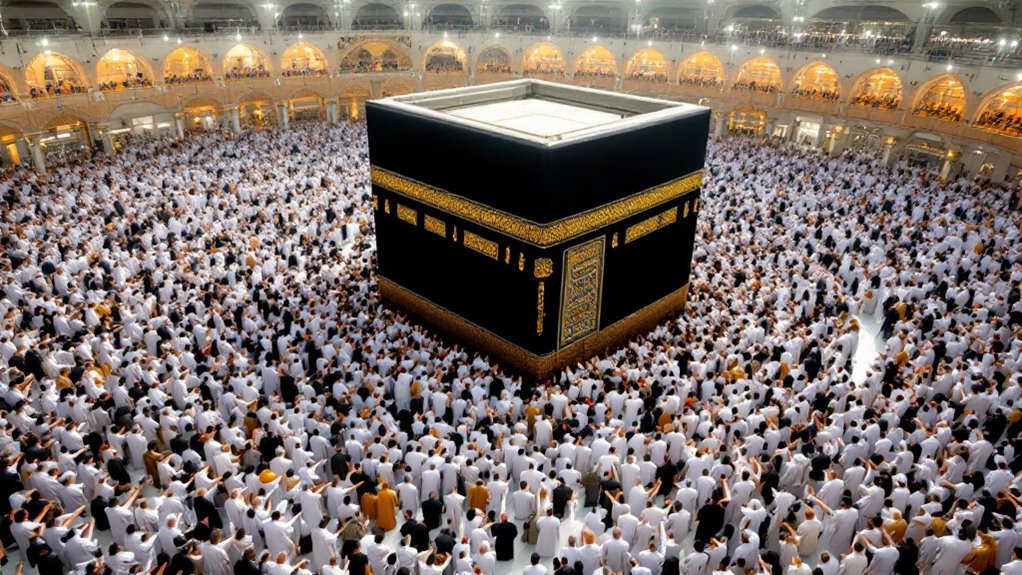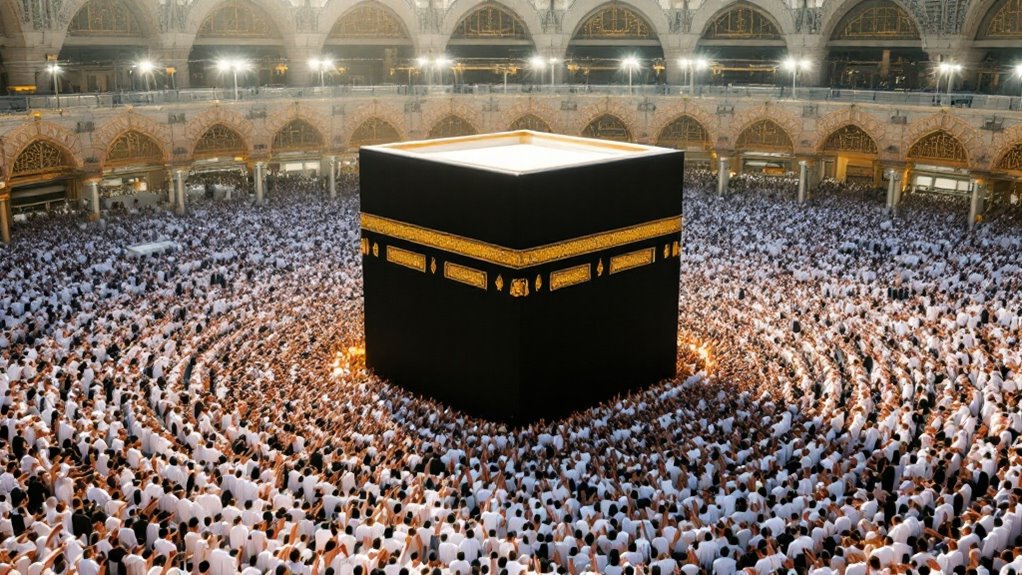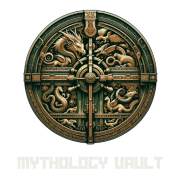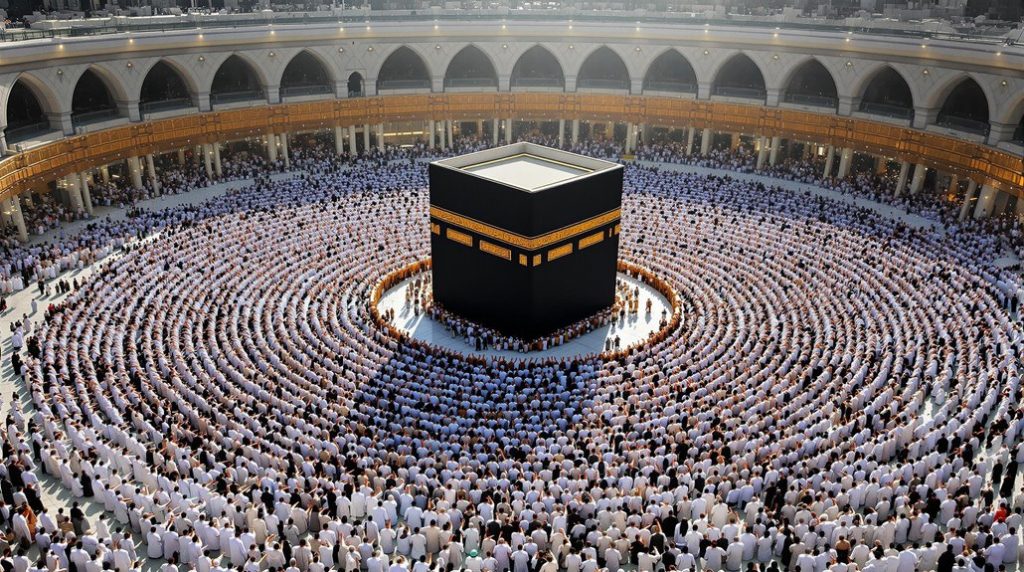The Black Stone of the Kaaba, like a cosmic thread weaving through time itself, has drawn me in to share the tale of Islam's most mysterious treasure.
This celestial artifact, said to have fallen from the heavens pure as morning frost, now stands as a midnight sentinel collecting humanity's burdens. It's a story that transcends mere religious symbolism, echoing ancient myths of sacred stones from cultures around the globe.
As pilgrims circle the Kaaba and reach towards this divine touchstone, they're participating in a ritual that's both deeply personal and universally connecting. This remarkable stone transforms strangers into spiritual kin.
Origins of the Sacred Stone
Islamic tradition holds the mystery of one of humanity's most enigmatic sacred objects – the Black Stone of the Kaaba. Its mythical beginnings speak of a celestial jewel, pristine white and radiant, gifted by God to Adam as a symbol of divine forgiveness. It has fascinated me to learn how this stone, believed to have fallen from Paradise, transformed from brilliant white to deep black as it took on the sins of countless pilgrims through their touch and kisses.
The stone's origin story echoes across cultures, bearing ancient themes of heaven touching earth. Some say it was an angel crystallized into stone after Adam's fall, while others see it as a direct link to Paradise. What is clear is that this sacred stone means more than simple religious symbolism – it represents humanity's unending search for a connection to the divine and our universal need for redemption. Research suggests possible connections to ancient Persian traditions, as sacred stone veneration was a significant aspect of Zoroastrian religious practices.
The Stone's Physical Journey
The Black Stone's journey mirrors humanity's transformation and resilience. Arriving in Mecca via Persian travelers, its installation by Muhammad in 605 CE showcases our pursuit of unity and purpose. Muhammad ingeniously resolved tribal tensions by having clan leaders collectively lift the stone on a cloth, proving that sacred objects can unite rather than divide.
Like powerful symbols, the stone has faced trials. When the Qarmatians took and broke it in 930 CE, the community didn't let this end its story. They embraced change, uniting the fragments in a silver frame that holds it today – mirroring how we can grow stronger after hardship. The stone's surface consists of several black fragments joined together with cement and appears deep reddish-brown in color.
Pilgrimage Rituals and Practices

Sacred rituals bind pilgrims to an ancient cosmic dance around the Black Stone, weaving together three core practices that echo humanity's eternal search for divine connection. Through Tawaf, I join millions who circle the Kaaba seven times, our collective movement creating a living orbit of devotion. In Sa'i, I retrace the desperate steps between Safa and Marwah, where Hagar's search for water transformed into a universal symbol of divine mercy. The Istilam draws me to touch, kiss, or gesture toward the Black Stone, connecting my spirit to an unbroken chain of seekers stretching back to Prophet Muhammad. Before entering this sacred space, I must embrace Ihram – a state of pure simplicity that strips away worldly distinctions, leaving only humble submission and pure intention. The sacred journey requires complete focus on Allah as pilgrims leave behind worldly concerns and distractions.
Symbol of Muslim Unity
From the vast reaches of the sky to the heart of Mecca, a celestial stone brings together Muslims from all walks of life in an everlasting bond that goes beyond borders, cultures, and the passage of time. I've seen firsthand how this sacred Black Stone, originally pure white before absorbing the sins of humanity, draws millions to its divine presence at the eastern corner of the Kaaba.
What I find most striking is how this cosmic touchstone transforms strangers into brothers and sisters in faith. Given to Abraham and Ishmael long ago, the stone's true power lies not in its physical form but in its ability to unite Muslims worldwide. When I witness pilgrims from every corner of the globe circling the Kaaba, reaching out to touch or kiss this heavenly fragment, I'm reminded that we're all part of something larger – a spiritual tapestry woven by divine hands.
Preservation Through the Ages

Throughout thousands of years of turbulent history, this celestial fragment has endured countless trials – from its initial placement by Prophet Muhammad in 605 CE to its dramatic kidnapping by the Qarmatians and subsequent ransom.
I'm struck by how this sacred stone, once whole and pure, mirrors humanity's own journey. Like us, it has been broken and reassembled, yet its spirit remains undiminished. From its pre-Islamic origins among the 360 idols to its current state within a silver frame, I see a chronicle of survival and adaptation. Today's preservation efforts by Saudi authorities continue this ancient legacy of guardianship.
What was once a symbol of Arabian fertility rites has transformed into a unifying force that transcends time. Despite scientific debates about its meteoritic nature, I believe its true power lies in its ability to withstand both physical and cultural transformations.
Frequently Asked Questions
Why Can Only Muslims Touch the Black Stone?
Listen up: only Muslims are allowed to touch the Black Stone because it symbolizes our sacred promise with Allah – a powerful spiritual link essential to our religious journey and divine connection.
What Happens if the Black Stone Is Damaged or Destroyed?
You're probably wondering – what if the Black Stone gets damaged or destroyed? Believe it or not, this has actually happened before. Back in 683 and 930 CE, the stone was broken and had to be repaired with silver frames. Even though it's been cracked and pieced back together, Muslims still believe the Black Stone holds the same spiritual significance. It remains a symbol of divine forgiveness, regardless of its physical state. In other words, as long as there's something there to kiss, pilgrims will keep paying their respects!
How Do Disabled or Elderly Pilgrims Perform the Touching Ritual?
For pilgrims with mobility challenges or age-related limitations, the ritualistic touching of the Black Stone is adapted out of compassion. These individuals have the option to simply point towards the stone from a distance that's comfortable for them. Special lanes are designated for their use, allowing easier access. A team of dedicated volunteers is on hand to guide and assist them throughout the process.
The most crucial aspect is that each pilgrim is free to choose a method that respects their personal limitations—whether that involves an alternative ritual or a modified approach. Flexibility and understanding are woven into the fabric of this sacred journey, ensuring that all who wish to participate can do so in a manner that honors their unique circumstances.
Is There Scientific Evidence About the Black Stone's Celestial Origin?
The Black Stone's mysterious origins have intrigued scholars for centuries. Its potential connection to meteoric activity hints at a celestial beginning, yet definitive proof eludes us. While chemical analyses suggest similarities to meteorite composition, the stone's sacred status makes modern testing difficult, keeping its origins shrouded in mystery.
How Is Crowd Control Managed During Peak Times at the Stone?
Managing the teeming crowds thronging to the Stone during peak times falls to dedicated guides and security personnel who orchestrate pilgrim flow like ancient guardians harnessing modern tools. Advanced simulations and queuing systems help these protectors keep visitors safe and serene as each seeks their deeply personal brush with the sacred stone.


